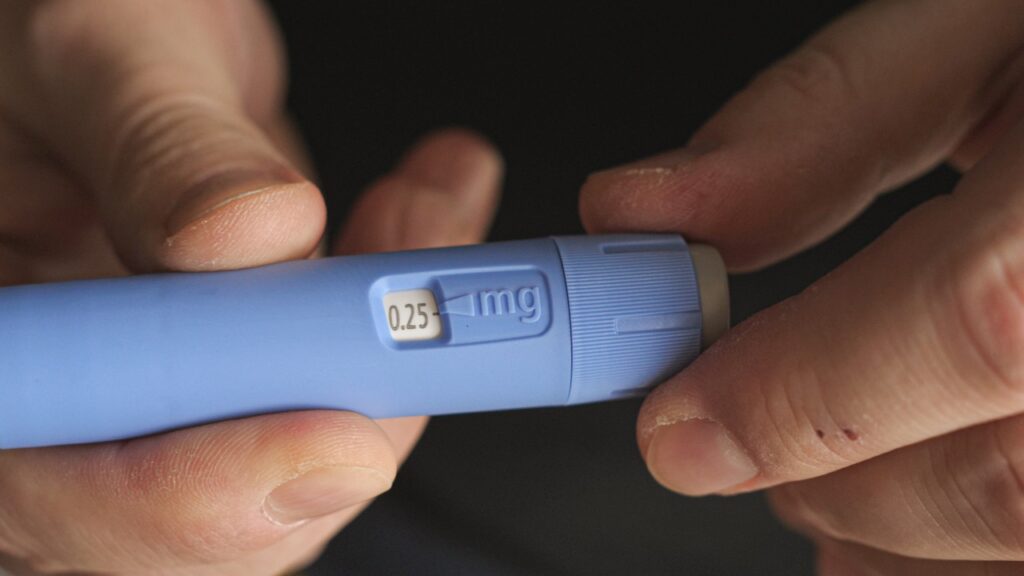Nausea With Ozempic: Causes, Symptoms and Solutions
For individuals pondering Ozempic or already on it, knowledge about its frequent side effect, nausea, can be beneficial. This article aims to shed light on:
- Ozempic’s purpose
- Understanding nausea
- Side effects tied to nausea
- Other possible side effects from Ozempic
- Nausea management on Ozempic
- Prevention of Ozempic side effects
- Common queries
Let’s delve in!
Understanding Ozempic and Weight Loss
Ozempic, a product by Novo Nordisk, is a once-weekly injectable medication chiefly used to regulate blood sugar levels in adults with type 2 diabetes. With type 2 diabetes, there is a risk that the body becomes resistant to insulin, necessitating treatments like Ozempic.
A notable side effect is appetite suppression, which can aid in weight management, especially in those with a BMI of 27 or higher. It’s essential to monitor for signs of inflammation, especially if you notice any lumps on your neck or swelling of the lips, as these could be indicative of an adverse reaction.
Ozempic shouldn’t be the sole method for weight management but rather combined with a balanced diet and consistent exercise. Its effectiveness can be seen through this combined approach, particularly if you plan to discontinue Ozempic after a short treatment period. Part of the GLP-1 receptor agonist class, Ozempic leverages semaglutide to target pancreatic cells, assisting patients in managing their weight.
It’s crucial to mention that Ozempic is approved only for adults with type 2 diabetes, not type 1 or similar conditions.
What is Nausea?
Most people have, at some point, encountered nausea, which manifests as an uneasy feeling in the stomach, often leading to vomiting. Signs of nausea encompass sweating, weakness, salivation, and the urge to vomit. Numerous reasons, like excessive alcohol, stress, pregnancy, or certain medications, can trigger nausea. Persistent, severe nausea warrants a doctor’s consultation.
Some signs that you may be experiencing nausea include:
- Sweating and an increased body temperature
- Excess saliva
- Weakness
- Shakiness
- Gagging and irritation in throat
- Urge to vomit.
Nausea is a common side effect of many medications and can occur for a variety of other reasons such as:
- Alcohol consumption
- Over-exertion
- Pregnancy
- Food poisoning
- Anxiety.
Why Does Ozempic Induce Nausea?
Though there’s no absolute reason. This can cause symptoms like nausea due to increased abdominal pressure and nerve stretching.
Recognizing Ozempic-Related Nausea Symptoms
If you suspect that Ozempic is causing nausea or if you’re curious about its potential side effects, here are some symptoms to be aware of:
Stomach Discomfort
A primary indicator of nausea is a feeling of discomfort in the stomach. It might feel like a mild ache or an unsettling sensation, as if your stomach is churning.
Abdominal Issues
Nausea can also present as abdominal cramps or bloating. Cramps can range from sharp pains to a continuous dull ache in the abdomen. Bloating might be noticeable, with the abdomen or lower belly appearing swollen and inflamed.
Digestive Changes
It’s common for nausea to be accompanied by diarrhea or constipation. These can arise before, during, or after the onset of nausea and can intensify the discomfort.
Reduced Appetite
Feeling nauseous often diminishes the desire to eat.
Digestive Reflux
Reflux or heartburn might accompany nausea. These symptoms are typically linked with indigestion. To reduce the risk of these symptoms, consider limiting intake of fried, fatty, or acidic foods.
Vomiting
Nausea can sometimes lead to vomiting. Though unpleasant, vomiting can sometimes relieve the nauseous feeling.
Feeling Off-Balance
Dizziness or a feeling of lightheadedness can be precursors to nausea. They often coexist, so if you experience one, the other might follow.
Always consult with a healthcare professional about any concerns related to medication side effects.
Unpacking Ozempic's Side Effects
Like most medications, Ozempic has potential side effects. Some prevalent ones include:
- Nausea
- Dizziness
- Abdominal pain
- Diarrhea
- Fatigue
- Shortness of breath
While these typically decrease over time, some rare, severe side effects like kidney problems, throat swelling, heart attack, pancreatitis, vision changes, gallstones, allergic reactions, and thyroid cancer have been reported. If such effects emerge, cease Ozempic use and seek medical attention.
Ozempic isn’t recommended for type 1 diabetes. Additionally, some users might notice skin reactions at the injection site.
Ozempic and Nausea: A Common Duo
During clinical trials of Ozempic, nausea emerged as the predominant side effect reported by patients. If you’re on Ozempic, there’s a possibility you might encounter this symptom.
The severity of nausea can vary. It might be mild and only present during the initial doses of Ozempic, or it could persist and be more intense.
Should the nausea become overwhelming or difficult to handle while on Ozempic, it’s essential to reach out to your healthcare provider to explore other treatment options.
Ozempic's Interaction with Other Drugs and Conditions
Ozempic may have adverse interactions with certain conditions and medications, especially other diabetes treatments. Pre-existing conditions like medullary thyroid cancer and MEN 2 can make Ozempic unsuitable. Those with heart conditions, or those pregnant or breastfeeding, should consult their doctor before starting Ozempic.
Hypoglycemia can result from mixing certain medications with Ozempic. Symptoms include drowsiness, confusion, and irritability. Also, Several studies have shown that some individuals using Ozempic may experience swelling, especially around the injection site, which can cause discomfort.
For in-depth information on drug interactions or alternative treatments, reach out to a healthcare professional.
Managing Nausea with Ozempic
While nausea from Ozempic often subsides on its own, there are several steps you can take to alleviate the discomfort:
Adjust Your Diet
Though there’s no official ‘Ozempic diet’, reducing your consumption of processed, fatty, or fried foods can help mitigate nausea. Steering clear of highly acidic and sugary foods can also prevent indigestion, which might intensify the nausea from Ozempic. Incorporate more protein and fiber into your meals and ensure you’re well-hydrated. Drinking ample water not only benefits your overall health but can also help reduce nausea.
Strategies to Consider
Opt for a Lower Ozempic Dose: Research indicates that higher doses of Ozempic can intensify nausea. If possible, consult your doctor about maintaining a lower dose. If you need to increase your dosage, do so gradually to minimize nausea.
Home Remedies for Nausea: Consider natural remedies like ginger tea or peppermint essential oils to alleviate nausea.
Eat Smaller, Frequent Meals: Opt for smaller, nutrient-rich meals and include low-GI fruits, vegetables, and slow-release carbs.
Fresh Air: A brief walk outdoors can sometimes help reduce nausea.
Mind Your Posture After Eating: Avoid lying down right after meals. Aim to remain upright for at least 30 minutes to an hour post-eating to prevent exacerbating nausea.
Consider Anti-Nausea Medication: If nausea becomes too intense or disruptive, discuss anti-nausea medication options with your doctor. Ensure any medication doesn’t interfere with Ozempic or other drugs you’re taking.
Always consult with your healthcare provider about any concerns or changes related to your medication.
Preventing Ozempic Side Effects
Preventing side effects is as vital as managing them. A proactive approach includes:
- Staying informed about potential interactions
- Seeking regular medical advice.
- Adhering to guidelines on storage and administration.
- Observing side effect symptoms and notifying your doctor.
For those who already struggle with diabetic retinopathy in their life, introducing Ozempic should be done under careful monitoring.
When contemplating Ozempic, one should account for family history, especially regarding thyroid issues. Furthermore, Ozempic is administered via an injection pen, ensuring accurate dosages.
Proper Storage of Ozempic
To ensure the efficacy of your Ozempic Pen, it’s crucial to store it appropriately.
Keep unused Ozempic Pens refrigerated between 36°F and 46°F (2°C to 8°C).
The Ozempic Pen in active use can be kept at room temperature, ranging from 59ºF to 86ºF (15ºC to 30ºC), but only for a maximum of 56 days.
Comprehensive Medical History Review
When discussing Ozempic with your healthcare providers, whether you’re considering starting the medication or have been using it, it’s vital to provide a complete and honest account of your medical history.
Ozempic may not be suitable for individuals with specific medical conditions or family histories, such as MTC or MEN 2. If these conditions apply to you, taking Ozempic could pose risks, including heightened gastrointestinal side effects like nausea.
Always share your full medical background with your healthcare team to ensure they can tailor your treatment safely and effectively.
Limiting Alcohol Consumption
Although no severe complications have been identified with alcohol consumption while on Ozempic, it might reduce the drug’s absorption and amplify feelings of nausea. Excessive alcohol can induce nausea, and when combined with Ozempic, this sensation might intensify.
It’s advisable to moderate your alcohol intake on Ozempic, especially if you’re using the medication for weight management, as alcohol can counteract its benefits.
If you’re concerned about reducing alcohol while on Ozempic, seek guidance from your healthcare providers.
Monitoring Your Body's Reactions
Closely observing how your body reacts to Ozempic is crucial. This vigilance helps you and your healthcare team track your progress and identify any potential health concerns.
In rare instances, you might experience an allergic reaction to Ozempic, which could manifest as:
- Facial and lip swelling
- Rashes or hives
- Breathing difficulties
If you observe any unusual symptoms or believe the medication isn’t suiting you, promptly consult your healthcare team.
Key Takeaways
Ozempic offers numerous benefits, but it can also come with gastrointestinal side effects, notably nausea.
Though this side effect is common, it can be disruptive to daily activities. Fortunately, it often subsides with time, and there are ways to mitigate its impact.
If the nausea you experience on Ozempic becomes particularly intense, it’s essential to discuss your concerns with your healthcare provider.
Frequently Asked Questions (FAQs)
Q: Can I discontinue Ozempic if nausea becomes unbearable?
A: Always consult your doctor before discontinuing any medication.
Q: Is Ozempic safe for pregnant women?
A: Ozempic’s safety for pregnant or breastfeeding women is not clearly determined. Always confer with a healthcare provider before initiating or continuing its use during pregnancy.
Remember, while Ozempic has many advantages, its side effects can’t be dismissed. By staying informed and observing best practices, users can enhance their experience and overall health.
Disclaimer: The information provided herein is for general awareness only and should not replace professional medical advice. Always seek consultation from a healthcare provider regarding any medical condition or treatment.
This article contains links to cover.health. Always review sources and verify information from trusted health professionals.






